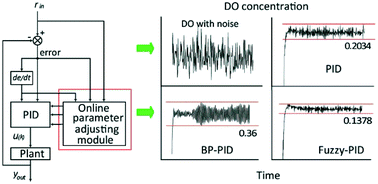Dissolved oxygen control strategies for the industrial sequencing batch reactor of the wastewater treatment process in the papermaking industry
Abstract
This paper proposes two strategies for controlling the dissolved oxygen concentration in the sequential batch reactor of the wastewater treatment process in the papermaking industry. Based on a previously developed sequential batch reactor simulation model, a fuzzy logic system and a neural network are integrated with a PID controller separately. According to the criteria defined in benchmark simulation model no. 1 (BSM1), three control strategies, namely, conventional PID, developed BP (back propagation)-PID and fuzzy-PID, applied in two cases with and without noise, have been investigated and assessed. For the cases without noise, both the developed controllers, i.e. BP-PID and fuzzy-PID, are superior to PID, wherein the fuzzy-PID controller not only improves the control performance but also reduces the aeration energy consumption. The results of further simulation with the interference of white noise reveal that the developed fuzzy-PID controller not only has better manipulated and controlled indexes than those of the BP-PID controller, it also demonstrates a good ability for anti-interference. These simulation results reveal the superiority of the developed fuzzy-PID control strategy in the dissolved oxygen control of the sequential batch reactor of the wastewater treatment process in the papermaking industry.



 Please wait while we load your content...
Please wait while we load your content...